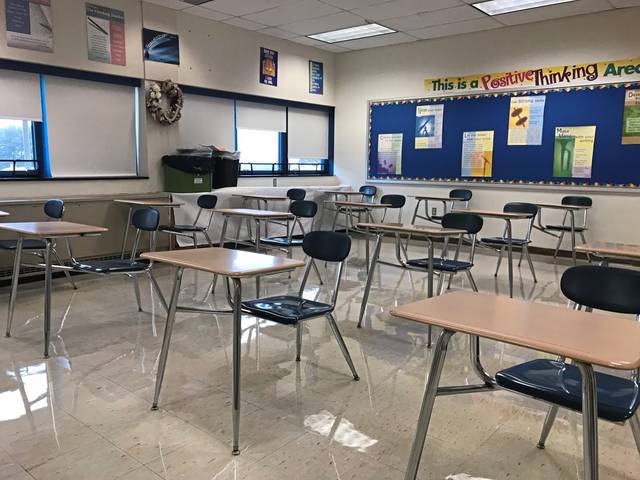Pa. officials encourage in-person learning for elementary students
Pennsylvania health and education officials Thursday encouraged school districts to return elementary school students to classrooms, at least partially.
“Beginning in the second semester, which typically begins around Jan. 25, and as local conditions permit, schools are going to be encouraged to allow for elementary school students to return back to campus, along with other targeted populations,” said Acting Secretary of Education Noe Ortega.
Until now, school districts in counties with “substantial” community transmission of covid-19 have been recommended to operate with fully remote models. The new recommendations allow districts in these conditions to also offer hybrid or blended approaches for younger learners and other student populations selected by their individual districts.
Officials emphasized that the updated guidance is not a mandate or requirement. Districts still may exercise the ultimate decision-making, taking into account community size, school resources and other concerns. There is no “one-size-fits-all” policy, Ortega said.
“What we’ve done in our guidance all along is making sure that the outcome for the student is something everyone holds in high regard,” Ortega said. “We want to make sure that we are not mandating or requiring anyone to come back to in-person instruction. We’re creating a pathway for them to do so.”
Schools must account for the health and safety of adults who work in buildings in order to safely make this change, he said.
Ortega and Pennsylvania Secretary of Health Dr. Rachel Levine cited the benefits of in-person learning, especially for elementary school students, as the primary reason for the change. They noted that further research and data indicate low transmission levels among young children in the classroom setting.
“The research on offering in-person instruction during covid-19 continues to emerge,” Levine said. “While it is impossible to eliminate the risk of disease transmission entirely within a school setting where community spread is present, recent studies have shown that when mitigation efforts, such as universal masking, physical distancing, and hand hygiene are followed, it may be safer for younger children, particularly elementary grade students, to return to in-person instruction.”
Levine said state data show students are more likely to contract covid-19 from participating in after-school gatherings and extracurricular activities.
Her statements coincide with local data as well. On Wednesday, Allegheny County Health Director Dr. Debra Bogen said just as many K-12 cases in the county were among students in remote learning as those in school buildings. The vast majority of cases, Bogen said during a Board of Health meeting, had come in close contact with someone with the virus, often a member of their own household.
Middle- and high school students are not included in the current recommendations, but Ortega said the goal is to gradually allow more in-person learning to those groups.
“We would like to begin to move into making sure that we can create the right conditions for schools to provide in-person instruction to as many grade levels as possible,” Ortega said. “This is very complicated. I think, oftentimes, we understand that within a family unit there are folks at different grade levels, there are folks who are working at home. …We’re trying to be mindful of how our decisions affect the entire ecosystem.”
Districts in the region have varied in their approaches to bringing students back during the first semester of instruction. Most have some degree of hybrid learning, while Pittsburgh Public Schools has remained fully-remote — minus a short attempt in November at a phased hybrid approach — and some districts have students in classrooms for most or all days of the week.
“We’ve been in-person five days a week for the entire year,” said Mark Holtzman, superintendent of McKeesport Area School District. “This is very encouraging, to kind of reinforce the efforts we’ve made.”
McKeesport Area has had students of all ages — not just elementary students — allowed in buildings every day, following mask and social distancing rules. Holtzman said the district has a fully-remote option selected by around 25% of students, and all students are sent home two hours early each day for teachers to better manage the online component.
According to the district’s online covid tracker, there have been 88 infections in the district so far — 37 students and 51 adults.
Some educators fear the updated guidance is ill-timed while the state continues to record unprecedented infection levels, hospitalizations and deaths because of covid-19.
“We have serious concerns about any plan to allow more students to attend school in-person learning without ensuring that all schools are following the state’s covid-19 health and safety guidance,” said Rich Askey, president of the Pennsylvania State Education Association. “Noticeably lacking from this updated guidance are stronger transparency mechanisms to ensure uniform and accurate reporting of covid-19 infections present in school communities.”
In a statement, Askey said there is still not a clear process to hold individual districts accountable for following health and safety rules. He called for immediate adjustments to “ensure that every school in Pennsylvania is following the state’s health and safety guidelines before we bring more students and staff members back into school buildings.”
Remove the ads from your TribLIVE reading experience but still support the journalists who create the content with TribLIVE Ad-Free.

